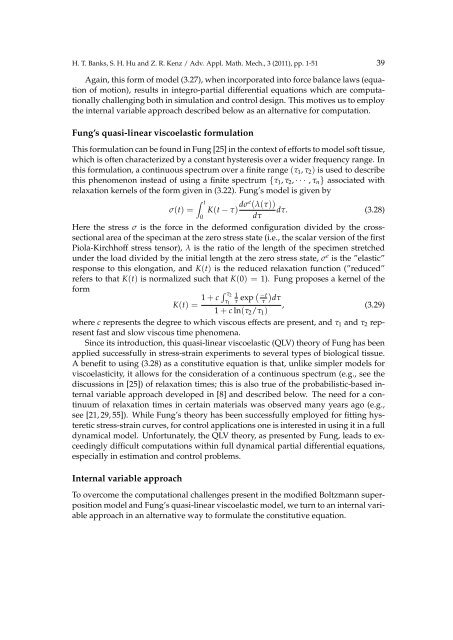A Brief Review of Elasticity and Viscoelasticity for Solids 1 Introduction
A Brief Review of Elasticity and Viscoelasticity for Solids 1 Introduction
A Brief Review of Elasticity and Viscoelasticity for Solids 1 Introduction
Create successful ePaper yourself
Turn your PDF publications into a flip-book with our unique Google optimized e-Paper software.
H. T. Banks, S. H. Hu <strong>and</strong> Z. R. Kenz / Adv. Appl. Math. Mech., 3 (2011), pp. 1-51 39<br />
Again, this <strong>for</strong>m <strong>of</strong> model (3.27), when incorporated into <strong>for</strong>ce balance laws (equation<br />
<strong>of</strong> motion), results in integro-partial differential equations which are computationally<br />
challenging both in simulation <strong>and</strong> control design. This motives us to employ<br />
the internal variable approach described below as an alternative <strong>for</strong> computation.<br />
Fung’s quasi-linear viscoelastic <strong>for</strong>mulation<br />
This <strong>for</strong>mulation can be found in Fung [25] in the context <strong>of</strong> ef<strong>for</strong>ts to model s<strong>of</strong>t tissue,<br />
which is <strong>of</strong>ten characterized by a constant hysteresis over a wider frequency range. In<br />
this <strong>for</strong>mulation, a continuous spectrum over a finite range (τ 1 , τ 2 ) is used to describe<br />
this phenomenon instead <strong>of</strong> using a finite spectrum {τ 1 , τ 2 , · · · , τ n } associated with<br />
relaxation kernels <strong>of</strong> the <strong>for</strong>m given in (3.22). Fung’s model is given by<br />
∫ t<br />
σ(t) = K(t − τ) dσe (λ(τ))<br />
dτ. (3.28)<br />
0<br />
dτ<br />
Here the stress σ is the <strong>for</strong>ce in the de<strong>for</strong>med configuration divided by the crosssectional<br />
area <strong>of</strong> the speciman at the zero stress state (i.e., the scalar version <strong>of</strong> the first<br />
Piola-Kirchh<strong>of</strong>f stress tensor), λ is the ratio <strong>of</strong> the length <strong>of</strong> the specimen stretched<br />
under the load divided by the initial length at the zero stress state, σ e is the ”elastic”<br />
response to this elongation, <strong>and</strong> K(t) is the reduced relaxation function (”reduced”<br />
refers to that K(t) is normalized such that K(0) = 1). Fung proposes a kernel <strong>of</strong> the<br />
<strong>for</strong>m<br />
K(t) = 1 + c ∫ τ 2 1<br />
τ 1 τ exp ( )<br />
−t<br />
τ dτ<br />
, (3.29)<br />
1 + c ln(τ 2 /τ 1 )<br />
where c represents the degree to which viscous effects are present, <strong>and</strong> τ 1 <strong>and</strong> τ 2 represent<br />
fast <strong>and</strong> slow viscous time phenomena.<br />
Since its introduction, this quasi-linear viscoelastic (QLV) theory <strong>of</strong> Fung has been<br />
applied successfully in stress-strain experiments to several types <strong>of</strong> biological tissue.<br />
A benefit to using (3.28) as a constitutive equation is that, unlike simpler models <strong>for</strong><br />
viscoelasticity, it allows <strong>for</strong> the consideration <strong>of</strong> a continuous spectrum (e.g., see the<br />
discussions in [25]) <strong>of</strong> relaxation times; this is also true <strong>of</strong> the probabilistic-based internal<br />
variable approach developed in [8] <strong>and</strong> described below. The need <strong>for</strong> a continuum<br />
<strong>of</strong> relaxation times in certain materials was observed many years ago (e.g.,<br />
see [21, 29, 55]). While Fung’s theory has been successfully employed <strong>for</strong> fitting hysteretic<br />
stress-strain curves, <strong>for</strong> control applications one is interested in using it in a full<br />
dynamical model. Un<strong>for</strong>tunately, the QLV theory, as presented by Fung, leads to exceedingly<br />
difficult computations within full dynamical partial differential equations,<br />
especially in estimation <strong>and</strong> control problems.<br />
Internal variable approach<br />
To overcome the computational challenges present in the modified Boltzmann superposition<br />
model <strong>and</strong> Fung’s quasi-linear viscoelastic model, we turn to an internal variable<br />
approach in an alternative way to <strong>for</strong>mulate the constitutive equation.

















